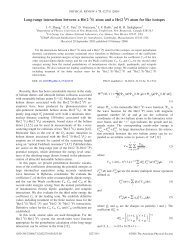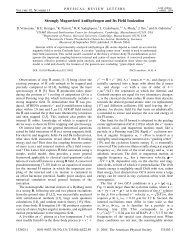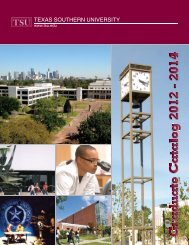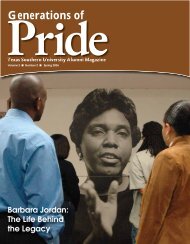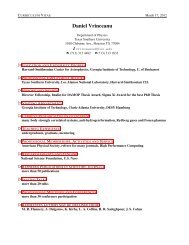NEWS - Texas Southern University
NEWS - Texas Southern University
NEWS - Texas Southern University
Create successful ePaper yourself
Turn your PDF publications into a flip-book with our unique Google optimized e-Paper software.
Statistics showed that, in 2000, 40 percent ofblack students nationwide attended schoolswith populations that are over 80 percent black.That, she maintained, did not indicate success.“Brown gave us legal access, acceptance andachievement, but lawcannot legislate heart,”she concluded.Law professor Dr.John Brittain arguedthat poverty, notrace, is a more prominentbarrier to equaleducation. It servesas a proxy for poorperformance, he toldthe audience; “thereis a greater correlationbetween povertyand achievement thanParticipants are, from left (seated): Cheryl Brown Henderson,Linda Brown, Dean McKen Carrington; (standing, from l)professor John Brittain, Dr. Merline Pitre, Dr. Franklin Jones,Dr. Cherry Gooden, professor James Douglas and AssociateDean Carroll Robinson.race and achievement,” he said. Fifty years afterthe Brown decision, the country has re-trendedtoward segregation and integration is no longerpursued. Brittain stressed that the fiscal strugglebetween urban and suburban schools representsthe new color line.Sisters Cheryl Brown Henderson and LindaBrown then addressed the crowd of mostlyThurgood Marshall law students, delving intothe personal history of the case and its positiveand negative ramifications. Brown, who wasthe child refused entry to an all-white school,discussed the climate of Topeka, Kan. at thetime of the lawsuit was filed. It was not a fightregarding the quality of black schools, but rathera reaction to the inaccessibility that African-American children had to their neighborhoodschools. While black families were not segregatedto certain Topeka neighborhoods, theirchildren were oftentimes bussed several milesfrom their homes to attend school, rather thanbe allowed to walk only a few blocks to attendclasses with white children. Brown v. Board ofEducation also fractured the black communityof Topeka, Brown said, as many black teacherswere threatened with the loss of their jobs.They were only promised jobs for the followingschool year if the decision upheld separateschooling; it was thought that, were the schoolsto integrate, white parents would not want theirchildren taught by black teachers.“Neither my parents nor I realized how farreaching this suit would become,” Brown toldthe audience. Over 300 suits were consolidatedunder the umbrella of Brown; the SupremeCourt did not decide ituntil three years after theinitial grievance was filed.“Brown was 105 yearsin the making,” Hendersonasserted, citing a list ofsimilar cases. In Kansasalone, 11 prior school segregationcases had beenfiled before Brown in 1951.The case stemmed from aconcerted effort on behalfof the NAACP to test localsegregation laws; the associationorganized groups ofAfrican-Americans to attempt to register theirchildren at the nearest white school to theirhome and report the result. Oliver L. Brownwas the tenth individual in the last experimentalgroup. Though her father’s role was significant,Henderson praised everyone involved. “It isthe ‘et al’ we really want to commemorate,” shetold listeners.Henderson then listed an array of benefitsof the Brown decision, not the least of whichwas the overturning of Plessy v. Ferguson andthe toppling of similar school segregation lawsin 21 states. Additionally, it defended humanrights. Conversely, however, the decisionresulted in countless African-American schools– many excellent – around the country beingclosed as well as a scarcity of African-Americanteachers, as many of them could no longer findemployment with majority school districts.Moreover, the ensuing years since the rulinghave seen the rise of bussing as a means to integrate,resources being withheld from schools inhigh minority and/or high poverty areas, andthe proliferation of private and magnet schools,which are often times inaccessible or unaffordableto black students. Though Henderson feltthat “we are absolutely, positively better offthan we were pre-Brown,” an important questionmust be broached, she said. “Does justicefor all mean anything?”32 Summer 2004 • GENERATIONS OF PRIDE



